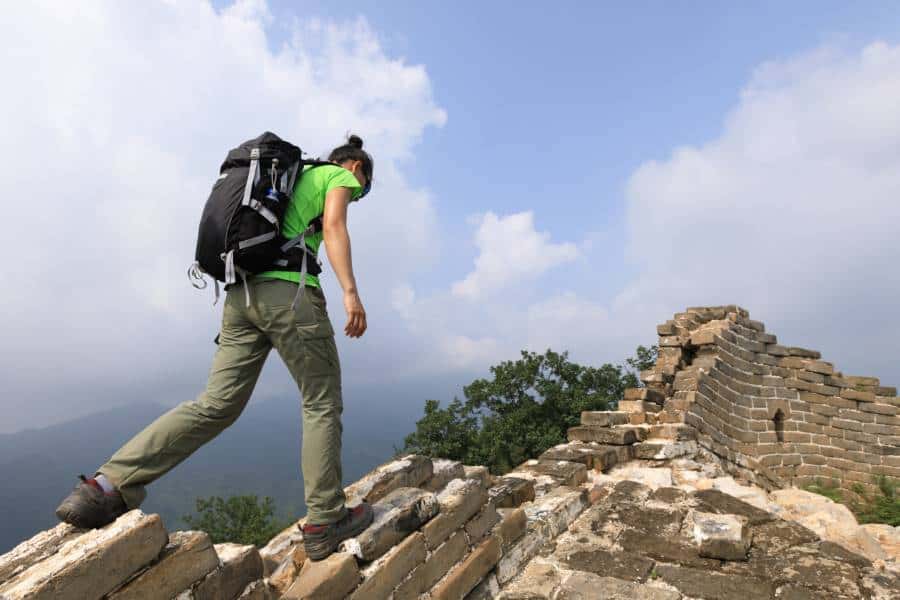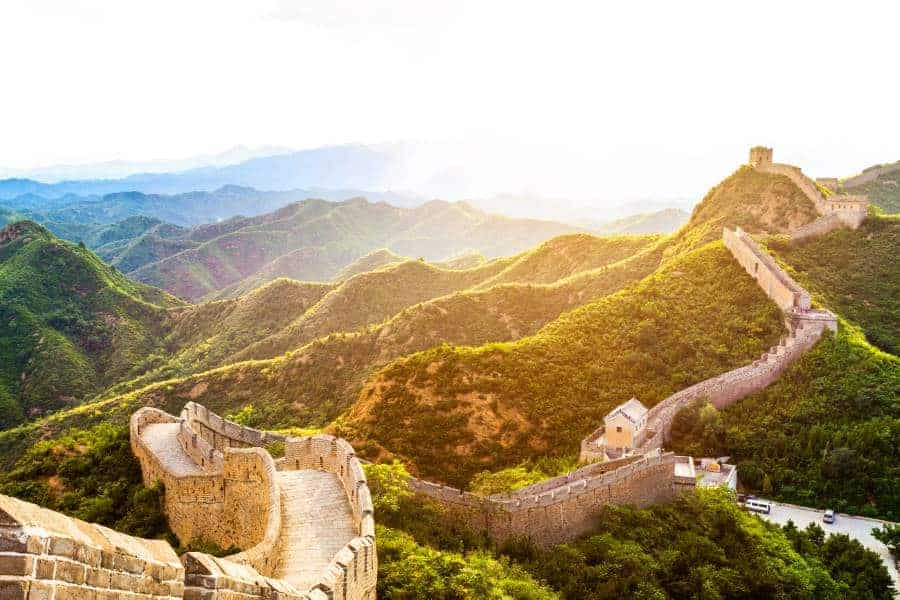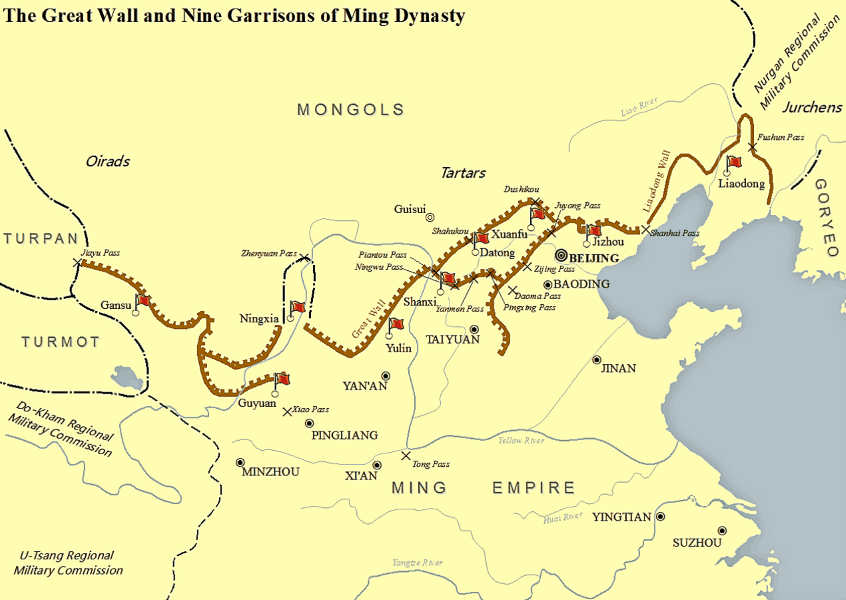Walking the Great Wall of China | How Long Would it Take? Is it Even Possible?
The main route of the Great Wall of China stretches over 5500 miles, from Hushan to Jiayuguan – tackling this epic monument on foot is no easy feat!
If you were to walk the Ming section of the Great Wall of China from end to end, it would take between 15 and 18 months. This section of the wall is the best preserved, and stretches in two long lines; one heading north-south, and the other going east-west.
However, there are many other sections of the wall, some only very recently discovered, bringing the total distance of the wall to over 13,000 miles.
How long does it take to walk the great wall of china?

The Great Wall of China is not just one wall, but a series of walls built by dynasties spanning centuries. Walking the entire 13,170-mile-long length would take you over 4210 hours or 175 days of non-stop walking.
Step Back 2000 Years in the Great Walls History
The Great Wall of China is one of the Seven Wonders of the World, and its title is definitely well earned. This staggering feat of engineering is over 2000 years old, in parts, and was a crucial line of defense for several ancient Chinese dynasties. Although it’s not actually possible to see the wall from outer space (contrary to popular belief), this magnificent structure dominates the Chinese landscape.
The iconic ramparts and fortresses of the wall snake over mountains, forest, and desert, creating an undulating path that beckons energetic hikers. This is by far the best way to see the Chinese countryside and become immersed in the country’s complex and exciting history. The Great Wall evokes images of imperial China; of great heroes and intense battles. Hundreds of thousands of soldiers, far from home, gave their lives on the wall, and their legacy lives on in its stone remains.
If you want to learn about China’s thrilling past, walk in the footsteps of imperial soldiers, and breathe in the magnificent Chinese landscape, the Great Wall is the place for you. The ultimate bucket list destination.

The Great Wall of China is Not One Wall
In reality, the term ‘Great Wall of China’ is a misnomer – there are many different border walls that make up the entirety of this remarkable monument. What many people think of as the Great Wall actually refers to the sections built during the Ming dynasty, when talented engineers began to use new construction materials, including bricks, stone, rammed earth, and mud. As a result, these long stretches of wall have withstood the test of time, and it’s possible to walk along many of them today.
Even the Ming walls, however, should not be described as one continuous ‘wall’. They consist of around 3900 miles of constructed stone wall, 225 miles of trenches, and 1400 miles of natural barriers. Where nature created natural defenses, the Chinese did not feel the need to construct an artificial wall, but still manned the area with watchtowers and beacons. Along the Ming wall, you can find over 5700 beacon towers, around 7000 watchtowers and 3350 individual wall platforms.
However, the Ming dynasty rulers were not the only wall-builders in ancient China. During the Warring States period (403BC-221BC) different rulers began the practice of building walls to protect their borders from dangerous invaders. These early walls were simple, made from wooden boards and compressed earth or gravel. Archaeologists have discovered their traces in several places, but in most cases, no visible remains have been left behind.
When the Qin dynasty finally emerged victorious from the Warring States period, they ordered the destruction of the old walls, and the construction of a new one on the northern border of their kingdom. The Qin wall was built using whatever construction materials were to hand, and it is estimated that hundreds of thousands of workers perished during its construction.
Today, archaeologists are discovering new sections of the Great Wall of China every year. In 2012, a 25-mile stretch of a previously unknown section of the wall was uncovered near Tianjin. The current total length is thought to be 13,170 miles, although it’s not possible to walk the whole way, as many parts of the wall are eroded, broken down or buried underneath centuries of rubble. Those who wish to walk the length of the wall must, in some places, follow the route down in the valleys below.
Great Wall Pioneers, People Who Have Attempted to Walk it’s Length
Very few people in the modern era have attempted to walk the principal Ming section of the Great Wall of China. On the 4th of May 1984, three men, led by Yaohui Dong, decided to investigate the wall and attempt to walk it end to end. They began at the Shanhai Pass, at the point where the wall meets the sea. The name of this important fortress comes from the Chinese for mountain (shan) and sea (hai), and for the security-conscious Ming rulers, it was the most important defense of the kingdom.
Yaohui Dong and his friends began walking and documented everything that they saw on the wall. The route took them through lush, green mountains, and sparse, arid plains, and even through the savage terrain of the Gobi Desert. Finally, on September 24th 1985, they reached the Jiayu Pass, at the Western extremity of the wall. They had marched for 508 days, and were the first people in recorded history to complete the entire route of the Ming wall.
Dong became of the Wall’s greatest advocates, and today he serves as the Vice Chairman of the Great Wall Society. This group, among others, aims to protect the wall from erosion, national disasters, and destruction by local mining companies. This important monument is a part of China’s heritage and must be preserved.

Walking the Great Wall Today
Most people who choose to walk the Great Wall of China today choose to walk either a small portion of it, or pick specific, picturesque spots to do a series of connected hikes. This is because many parts of the wall are very run down, and it’s not possible to walk all the way along the top. In the areas close to Beijing, and other tourist hotspots, the Chinese government has invested a significant amount in the upkeep of the wall, making it a very pleasant, if challenging, hike.
The most popular parts of the wall lie near to the capital, including Badaling and Mutianyu. Here you are likely to find the wall crammed with tourists in peak season, making it difficult to walk. However, these sections are particularly well-maintained, and set among glorious scenery, with views over the forest.
For a day trek, the section between Jinshanling and Simatai is very popular. This section only attracts tour groups at Jinshanling, and once you set off, you’re likely to meet very few people along the way. The wall is crumbling and broken down in places, but remains accessible, and this 11km hike takes you through some of the region’s finest scenery.
Longer treks are possible at other points in the wall, and generally, the further west you go, the fewer people you are likely to see. The section of the wall in the Gobi Desert is particularly unforgiving, and many sections have been covered by rubble or sand. However, this remarkable region is well worth a visit, if only to marvel at the feat of engineering it took to construct the wall in such an inhospitable environment.

It’s More Than Just a Wall
It’s easy to get to the wall near tourist spots such as Badaling, so why do many people feel the desire to walk great distances along its length? For those few people who have opted to walk the entirety of the Great Wall of China, the main attraction is not the wall itself. The Great Wall is actually surrounded by historic villages and towns that have grown up in the shadow of this remarkable structure. Part of the pleasure of walking along the wall is meeting local people, visiting their homes, and learning about their culture.
In many cases, the way of life that surrounds the wall goes back centuries, as this important defensive monument facilitated trade, and kept the local people safe from invasion. As you stand on the top of the wall, looking down on the ramparts, it’s easy to imagine the soldiers, horses and people who would have manned the fortresses in years gone by.
Today, traces of this cultural vitality still remain along the length of the wall. In many places, local residents will be happy to welcome you into their homes, and share ancient stories of the history of the wall.
The Great Wall Has Something For Everyone
Even those who get tired of walking will find themselves well served at the Great Wall of China. Two hours north of Badaling, the spectacular site of Mutianyu is one of the most popular sections of the wall. Here you can climb to the top of the wall on foot or take the chairlift, but the descent is much more exciting.
The toboggan installed at Mutianyu allows visitors to hurtle down to the ground on a zig-zagging slide, with perfect views of the forests and ramparts all the way down. Just the thing for sore feet after a long walk along the wall!
Walking the whole wall is out of the question for 99.99% of us, but why not do a half day walk, or for the more adventurous, a 2,3 or 7-day walk camping and meeting the locals along the way.
Why not check out our Travel Bucket List and start making your own bucket list right on this website.
.0
If you liked this post please share it on:

Helen Flatley
Add items to your ‘Bucket List’ or ‘Done List‘ by pressing the buttons where you see them throughout this website.
Related Bucket List Items
Walk on The Great Wall of China
Complete a 3 day walk on the Great Wall of China
Visit China
Celebrate Chinese New Year in China
Learn to speak Mandarin
Recent Posts
- What is Italy Known For?
- The Bucket List 10 -⏩ What are the Top 10 Bucket List Items?
- What is New York Famous For? 14 Things That Make New York the State it is
- What is Vietnam known for? 12 Things That Make Vietnam the Country it is
- Why is Route 66 Famous? 🚗15 Things to See Along the Way
- What is Lithuania Known For? 12 Things That Make Lithuania the Country it is
- What is Africa Known For? 7 Things That Make Africa the Continent it is
- 15 Best Places to Visit in February | USA, Europe and the World
- What Is Egypt Famous For? 7 Things That Make Egypt the Country it is
- What is Mexico Famous For? 11 Things That Make Mexico the Country it is

